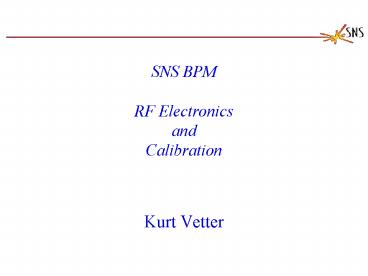SNS BPM RF Electronics and Calibration - PowerPoint PPT Presentation
1 / 23
Title:
SNS BPM RF Electronics and Calibration
Description:
Repeat for orthogonal plane (Hor,Vert) Assumptions ... Repeat for Orthogonal Plane (Hor, Vert) RF Calibration Methodology. Calibration Implementation ... – PowerPoint PPT presentation
Number of Views:43
Avg rating:3.0/5.0
Title: SNS BPM RF Electronics and Calibration
1
SNS BPMRF Electronicsand Calibration
- Kurt Vetter
2
Outline
- Why RF BPM Signal Processing is Necessary
- RF Electronics
- BPM Calibration
- Status
3
The Need For RF BPM Signal Processing
- Minimum of two RF BPMs in the baseline
- Baseline AP 1st-Turn requirement
- 1mm resolution over 20mm aperture
- BaseBand Test Results
- Preliminary BaseBand laboratory measurements
verify 1st-turn SNR of 16dB (require 30dB SNR for
1mm resolution) - Expect SNR to degrade in Real System due to
external noise coupling which desensitizes
receiver. - RF BPM Signal Processing
- Achieve 30dB SNR on 1st-Turn (Centered Beam
lowest SNR) - Assures 1mm Resolution Requirement on 1st-Turn
- Highly integrated implementation approach will
fit on existing AFE plug-in board
4
1st-Turn Spectral Analysis (M. Kesselman)
Beam Spectrum
BPM Signal Spectrum
Filtered BaseBand Spectrum
5
1st-Turn Concept Using 402.5MHz Beam Spectral
Component
1 of 4 Channels
Low Frequency Processing
Diplexor Fc17MHz
To ADC
Mux
From PU
CPL -10dB
1st Few-Turns
(L10)
5Vp
400MHz BP Helical Filter Q20
Cal
3dB Pad
5MHz LPF
3dB Pad
20dB Pad
Cal Signal
PreScaler 1/2
398.5MHz 10dBm
402.5MHz
805MHz
3.3V
7V
Split 4-way 0-deg
Silicon Labs RF/IF Synthesizer Si4133
PWDN
Lo Ch.2
SDATA
From FPGA
Lo Ch.3
SCLK
Lo Ch.4
SEN
SiGe 25dB
Ref Freq 16Frev (16MHz)
6
Rf Receiver Calculations
- Noise Floor
- -174dBm/Hz 10Log(5MHz) RF Attenuation
-55dBm - Signal Level (1st-Turn) 38mA (ave) Centered Beam
- 27dBm _at_ Pickup
- (1/4) Heliax Cable loss 4dB/100ft _at_ 400MHz
- Assume 300ft of Heliax
- Loss 12dB _at_ 400MHz
- SNR 30dB
- 38mA (ave) 20mm Offset Beam
- 44dBm _at_ Pickup
- SNR 50dB
7
RF Receiver 1st-Turn Analysis(38mA average Beam
Current)
SNR 50dB Off Centered Beam
SNR 30dB(min) Centered Beam
8
Si4133 Frequency Synthesizer
9
Si4133 Synthesizer EVAL Programming Display
10
RF PCB Stackup
11
BPM Calibration
- Philosophy
- Achieve system gain normalization at BaseBand and
RF by measuring System Through-Port response to
remove systematic errors. - Why This Works
- Using Log-Ratio processing, channel gains can be
expressed as a constant obtained by measurement
(S21 or Beam Based Alignment)
Gain Constant Obtained by S21 measurement
Interested in Ratio
12
Measurement Setup
13
Open Circuit BPM
14
S21 H/V Ring BPM (Open 21cm Stripline)
-46dB _at_ 5MHz
15
BPM S21 Measurements21cm Open Circuit Ring BPM
- 33dB H/V Sensitivity
- improvement at 400MHz
16
BaseBand Calibration Methodology
- Assumptions
- BPM physical and electromagnetic variations
considered constant (verified by measurement of
small population) - Calibration Methodology
- Inject 100ns (5V) Pulse into (1/4) Heliax
transmission line via 10dB coupler towards
pickup. - Measurement capabilities
- S21 of two adjacent orthogonal planes
- S21 of parallel plane
- S11, reflected pulse from open stripline of
incident port - Repeat for orthogonal plane (Hor,Vert)
17
RF Calibration Methodology
- Assumptions
- BPM physical and electromagnetic variations
considered constant (verified by measurement of
small population) - Calibration Methodology
- Inject 402.5MHz Sinusoid into (1/4) Heliax
transmission line via 10dB coupler towards
pickup. - Measure
- S21 of two adjacent orthogonal planes
- S21 of parallel plane
- Repeat for Orthogonal Plane (Hor, Vert)
18
Calibration Implementation
Ch.1
FPGA
S11, S14
CPL -10dB
Cal Pulse (tw100ns)
Horizontal Cal. BB/RF
402.5MHz
LabView Curve Fit Peak Find Gain Normalization
Ch.2
S21, S24
PCI
Ch.3
S31, S34
- BPM
- Open Ckt
- Stripline
- 21cm
Ch.4
S41, S44
CPL -10dB
Cal Pulse (tw100ns)
Vertical Cal. BB/RF
402.5MHz
19
H/V Plane Time Domain Transfer Function (S21)
Calibration Pulse
Differentiated Pulse coupled across planes
5V pulse injected into coupled port of 10dB
coupler Approximately 300ft of ¼ Heliax on each
BPM port
20
BaseBand Bessel LPF Impulse Response
Calibration Pulse
Gaussian LPF Impulse Response
Same setup as previous slide with Gaussian 5MHz
LPF
21
BaseBand Bessel LPF Impulse Response
Expanded Gaussian LPF Impulse Response
2.3mV peak
- Pulse width 74ns
- Acquire 4-samples/pulse (min) for fs64MHz
(Ts15.625ns)
22
Calibration Post Processing
- All calculations done in LabView
- Calibration Algorithm
- Curve-Fit data to determine peak of each channel
- Normalize with respect to maximum channel
- Store normalized gain coefficients
- Scale raw data by normalized gain coefficients
- Calibration Process performed for both RF and
BaseBand. Two sets of Calibration Coefficients
required.
23
RF Electronics Status
- Detailed Design Complete
- Schematic in shop working on layout
- Completed Proof-of-Principal Calibration
Concept - Synthesizer characterization in process































